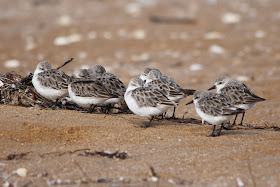We live in an interesting state! At at time when the governments of several Australian states have banned recreational waterfowl hunting the current Victorian government is
actively promoting the activity.
We live in a democracy and I believe there are some 42,000 recreational shooters in Victoria. Game hunting of waterfowl and Stubble quail is an activity that goes back generations in many regional communities. Member organisations such as
Field and Game Australia (FGA) have a considerable voice. Interestingly one founding focus of the FGA was the conservation of dwindling and damaged wetlands (with the consequent loss of game to shoot). The FGA continues this work and I am often confronted by this irony when enjoying my own recreational pursuit.
 |
| Royal spoonbill, Phillip Island |
This happened again when I turned from photographing this spoonbill to take a scene shot. I find that the wetland is owned / sponsored by the local branch of the FGA. There are many such examples across the state.
 |
| Is this the longest wetland name ever? |
An example of how entrenched the hunting culture is in this state is that many of Victoria's best known bushland reserves are classified as State Game Reserves, many of which are available for shooters to hunt (within prescribed seasons).
The current government has set up a new authority called Game Victoria to supervise the duck season. This used to be done by the Department of Sustainability and Environnment. It is my understanding that the new body is filled with affiliates of FGA and the Sporting Shooters Association as outlined in this
Melissa Fyfe article in The Age.
Generally speaking the trends are towards facilitating the licensing of shooters (with more flexible licence packages etc) and the "development of improved hunting opportunities" as expounded in the Government's media release
Creation of Game Victoria signals new era.
 |
| Tucking in! Royal spoonbill |
 |
| Black swan and cygnet also enjoying the wetland |
While I do not understand the attraction of shooting birds as recreation I am not against the concept of sustainable hunting that puts a meal on the plate. I have no problems with anything that is proven to support regional communities.
Position Statement
BirdLife Australia considers that recreational waterfowl hunting should not be allowed in Australia and its Territories.
This Policy supersedes RAOU Policy on Waterfowl Hunting (2) adopted by Council on 29 May 1994. The scope of this policy is limited to the hunting of waterfowl for recreational purposes, and not where hunting is for traditional food or ceremonial functions, or to mitigate the effects of agricultural or environmental damage.
Reasons for the change of Policy
- We believe society in general, and our Members in particular, consider the killing of native birds for recreational purposes is an inappropriate interaction between people and their natural environment,
- It has a potentially negative impact on bird conservation through: killing of non-game species, damage to wetland habitat, and disturbance of birds; these impacts are not likely to be adequately off-set by shooting industry-funded habitat protection and restoration programs,
- While BirdLife Australia is not primarily concerned with animal welfare issues, we cannot support an activity that on the balance of probability causes pain and suffering to animals, for no purpose other than recreation.
- The pro-waterfowl hunting lobby has not shown sufficient commitment to ensuring or demonstrating sustainability of the resource.














































